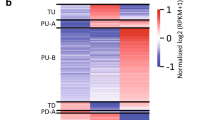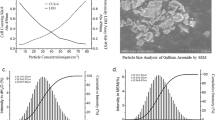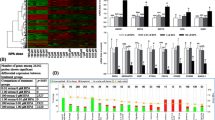Abstract
Workers occupationally exposed to cadmium, cobalt and lead have been reported to have increased levels of DNA damage. To analyze whether in vivo relevant concentrations of heavy metals cause systematic alterations in RNA expression patterns, we performed a gene array study using primary normal human bronchial epithelial cells. Cells were incubated with 15 μg/l Cd(II), 25 μg/l Co(II) and 550 μg/l Pb(II) either with individual substances or in combination. Differentially expressed genes were filtered out and used to identify enriched GO categories as well as KEGG pathways and to identify transcription factors whose binding sites are enriched in a given set of promoters. Interestingly, combined exposure to Cd(II), Co(II) and Pb(II) caused a coordinated response of at least seven stress response-related transcription factors, namely Oct-1, HIC1, TGIF, CREB, ATF4, SRF and YY1. A stress response was further corroborated by up regulation of genes involved in glutathione metabolism. A second major response to heavy metal exposure was deregulation of the cell cycle as evidenced by down regulation of the transcription factors ELK-1 and the Ets transcription factor GABP, as well as deregulation of genes involved in purine and pyrimidine metabolism. A third and surprising response was up regulation of genes involved in steroid metabolism, whereby promoter analysis identified up regulation of SRY that is known to play a role in sex determination. A forth response was up regulation of xenobiotic metabolising enzymes, particularly of dihydrodiol dehydrogenases 1 and 2 (AKR1C1, AKR1C2). Incubations with individual heavy metals showed that the response of AKR1C1 and AKR1C2 was predominantly caused by lead. In conclusion, we have shown that in vivo relevant concentrations of Cd(II), Co(II) and Pb(II) cause a complex and coordinated response in normal human bronchial epithelial cells. This study gives an overview of the most responsive genes.



Similar content being viewed by others
References
Barbosa F Jr, Corrêa Rodrigues MH, Buzalaf MR, Krug FJ, Gerlach RF, Tanus-Santos JE (2006a) Evaluation of the use of salivary lead levels as a surrogate of blood lead or plasma lead levels in lead exposed subjects. Arch Toxicol 80(10):633–637
Barbosa F Jr, Sertorio JT, Gerlach RF, Tanus-Santos JE (2006b) Clinical evidence for lead-induced inhibition of nitric oxide formation. Arch Toxicol 80(12):811–816
Barlow CA, Kitiphongspattana K, Siddiqui N, Roe MW, Mossman BT, Lounsbury KM (2008) Protein kinase A-mediated CREB phosphorylation is an oxidant-induced survival pathway in alveolar type II cells. Apoptosis 13(5):681–692
Bébien M, Salinas S, Becamel C, Richard V, Linares L, Hipskind RA (2003) Immediate-early gene induction by the stresses anisomycin and arsenite in human osteosarcoma cells involves MAPK cascade signaling to Elk-1, CREB and SRF. Oncogene 22(12):1836–1847
Beyersmann D, Hartwig A (2008) Carcinogenic metal compounds—recent insight in molecular and cellular mechanisms. Arch Toxicol 82:493–512
Bolstad B (2007) affyPLM: Methods for fitting probe level models to Affy data. http://www.bioconductor.org/repository/devel/vignette/affyPLM
Bolt HM, Foth H, Hengstler JG, Degen G (2004) Carcinogenicity categorization of chemicals—new aspects to be considered in a European perspective. Toxicol Lett 151:29–41
Chen WY, Wang DH, Yen RC, Luo J, Gu W, Baylin SB (2005) Tumor suppressor HIC1 directly regulates SIRT1 to modulate p53-dependent DNA-damage responses. Cell 123(3):437–48
Deng HB, Parekh HK, Chow KC, Simpkins H (2002) Increased expression of dihydrodiol dehydrogenase induces resistance to cisplatin in human ovarian carcinoma cells. J Biol Chem 277(17):15035–15043
Development Core Team (2007) R: a language and environment for statistical computing. R Foundation for Statistical Computing, Vienna. ISBN 3-900051-07-0. URL http://www.R-project.org
Devi SS, Biswas AR, Biswas RA, Vinayagamoorthy N, Krishnamurthi K, Shinde VM, Hengstler JG, Hermes M, Chakrabarti T (2007) Heavy metal status and oxidative stress in diesel engine tuning workers of central Indian population. J Occup Environ Med 49(11):1228–1234
Elkon R, Linhart C, Sharan R, Shamir R, Shiloh Y (2003) Genome-wide in-silico identification of transcriptional regulators controlling cell cycle in human cells. Genome Res 13(5):773–780
Falcon S, Gentleman R (2007) Using GO stats to test gene lists for GO term association. Bioinformatics 23:257–258
Grönroos E, Terentiev AA, Punga T, Ericsson J (2004) YY1 inhibits the activation of the p53 tumor suppressor in response to genotoxic stress. Proc Natl Acad Sci U S A 101(33):12165–70
Gump BB, Stewart P, Reihman J, Lonky E, Darvill T, Parsons PJ, Granger DA (2008) Low-level prenatal and postnatal blood lead exposure and adrenocortical responses to acute stress in children. Environ Health Perspect 116(2):249–255
Hengstler JG, Bolt HM (2007) Induction and control of oxidative stress. Arch Toxicol 81(12):823–824
Hengstler JG, Bolm-Audorff U, Faldum A, Janssen K, Reifenrath M, Götte W, Jung D, Mayer-Popken O, Fuchs J, Gebhard S, Bienfait HG, Schlink K, Dietrich C, Faust D, Epe B, Oesch F (2003a) Occupational exposure to heavy metals: DNA damage induction and DNA repair inhibition prove co-exposures to cadmium, cobalt and lead as more dangerous than hitherto expected. Carcinogenesis 24(1):63–73
Hengstler JG, Bogdanffy MS, Bolt HM, Oesch F (2003b) Challenging dogma: thresholds for genotoxic carcinogens? the case of vinyl acetate. Annu Rev Pharmacol Toxicol 43:485–520
Horiguchi H, Oguma E, Kayama F (2006) Cadmium and cisplatin damage erythropoietin-producing proximal renal tubular cells. Arch Toxicol 80(10):680–686
Kao LW, Crosswell MJ, Weisz J (1979) Steroid metabolism by the lung: conversion of dihydrotestosterone to 5 alpha-androstan-3 alpha, 17 beta-diol by rat lung tissue in vitro. Endocrinology 104(3):664–666
Kim DW, Kim KY, Choi BS, Youn P, Ryu DY, Klaassen CD, Park JD (2007) Regulation of metal transporters by dietary iron, and the relationship between body iron levels and cadmium uptake. Arch Toxicol 81(5):327–334
Lange PS, Chavez JC, Pinto JT, Coppola G, Sun CW, Townes TM, Geschwind DH, Ratan RR (2008) ATF4 is an oxidative stress-inducible, prodeath transcription factor in neurons in vitro and in vivo. J Exp Med 205(5):1227–1242
Lee MJ, Ayaki H, Goji J, Kitamura K, Nishio H (2006) Cadmium restores in vitro splicing activity inhibited by zinc-depletion. Arch Toxicol 80(10):638–643
Lehmann T, Köhler C, Weidauer E, Taege C, Foth H (2001) Expression of MRP1 and related transporters in human lung cells in culture. Toxicology 167:59–72
Lilienblum W, Dekant W, Foth H, Gebel T, Hengstler JG, Kahl R, Kramer PJ, Schweinfurth H, Wollin KM (2008) Alternative methods to safety studies in experimental animals: role in the risk assessment of chemicals under the new European Chemicals Legislation (REACH). Arch Toxicol 82(4):211–236
Liu ZM, Huang HS (2008) Inhibitory role of TGIF in the As2O3-regulated p21 WAF1/CIP1 expression. J Biomed Sci 15(3):333–342
Montenegro MF, Barbosa F Jr, Sandrim VC, Gerlach RF, Tanus-Santos JE (2006) A polymorphism in the delta-aminolevulinic acid dehydratase gene modifies plasma/whole blood lead ratio. Arch Toxicol 80(7):394–398
Nampoothiri LP, Agarwal A, Gupta S (2007) Effect of co-exposure to lead and cadmium on antioxidant status in rat ovarian granulose cells. Arch Toxicol 81(3):145–150
Pinte S, Stankovic-Valentin N, Deltour S, Rood BR, Guérardel C, Leprince D (2004) The tumor suppressor gene HIC1 (hypermethylated in cancer 1) is a sequence-specific transcriptional repressor: definition of its consensus binding sequence and analysis of its DNA binding and repressive properties. J Biol Chem 279(37):38313–38324
Runge DM, Stock TW, Lehmann T, Taege C, Bernauer U, Stolz DB, Hofmann S, Foth H (2001) Expression of cytochrome P450 2E1 in normal human bronchial epithelial cells and activation by ethanol in culture. Arch Toxicol 75:335–345
Saravana Devi S, Vinayagamoorthy N, Agrawal M, Biswas A, Biswas R, Naoghare P, Kumbhakar S, Krishnamurthi K, Hengstler JG, Hermes M, Chakrabarti T (2008) Distribution of detoxifying genes polymorphism in Maharastrian population of central India. Chemosphere 70(10):1835–1839
Schild-Poulter C, Shih A, Tantin D, Yarymowich NC, Soubeyrand S, Sharp PA, Haché RJ (2007) DNA-PK phosphorylation sites on Oct-1 promote cell survival following DNA damage. Oncogene 26(27):3980–3988
Schweikl H, Hiller KA, Eckhardt A, Bolay C, Spagnuolo G, Stempfl T, Schmalz G (2008) Differential gene expression involved in oxidative stress response caused by triethylene glycol dimethacrylate. Biomaterials 29(10):1377–1387
Sekido R, Lovell-Badge R (2008) Sex determination involves synergistic action of SRY and SF1 on a specific Sox9 enhancer. Nature [Epub ahead of print]
Spangenberg C, Lausch EU, Trost TM, Prawitt D, May A, Keppler R, Fees SA, Reutzel D, Bell C, Schmitt S, Schiffer IB, Weber A, Brenner W, Hermes M, Sahin U, Tureci O, Koelbl H, Hengstler JG, Zabel BU (2006) ERBB2-mediated transcriptional up-regulation of the alpha5beta1 integrin fibronectin receptor promotes tumor cell survival under adverse conditions. Cancer Res 66(7):3715–3725
Stehfest E, Torky A-RW, Glahn F, Foth H (2006) Non destructive micro method for MRP1 functional assay in human lung tumor cells. Arch Toxicol 80(3):125–133
Tantin D, Schild-Poulter C, Wang V, Haché RJ, Sharp PA (2005) The octamer binding transcription factor Oct-1 is a stress sensor. Cancer Res 65(23):10750–10758
Telisman S, Colak B, Pizent A, Jurasović J, Cvitković P (2007) Reproductive toxicity of low-level lead exposure in men. Environ Res 105(2):256–266
Thompson J, Bannigan J (2008) Cadmium: toxic effects on the reproductive system and the embryo. Reprod Toxicol 25(3):304–315
Torky A, Raemisch A, Glahn F, Foth H (2008) Arachidonic acid pathway activates multidrug resistance related protein in cultured human lung cells. Arch Toxicol 82:323–332
Trost TM, Lausch EU, Fees SA, Schmitt S, Enklaar T, Reutzel D, Brixel LR, Schmidtke P, Maringer M, Schiffer IB, Heimerdinger CK, Hengstler JG, Fritz G, Bockamp EO, Prawitt D, Zabel BU, Spangenberg C (2005) Premature senescence is a primary fail-safe mechanism of ERBB2-driven tumorigenesis in breast carcinoma cells. Cancer Res 65:840–849
Yang ZF, Mott S, Rosmarin AG (2007) The Ets transcription factor GABP is required for cell-cycle progression. Nat Cell Biol 9(3):339–346
Zhang HM, Li L, Papadopoulou N, Hodgson G, Evans E, Galbraith M, Dear M, Vougier S, Saxton J, Shaw PE (2008) Mitogen-induced recruitment of ERK and MSK to SRE promoter complexes by ternary complex factor Elk-1. Nucleic Acids Res 36(8):2594–2607
Acknowledgments
Microarray analysis was conducted at the IZKF Leipzig at the Faculty of Medicine of the University Leipzig (Projekt Z03).
Author information
Authors and Affiliations
Corresponding authors
Electronic supplementary material
Below is the link to the electronic supplementary material.
204_2008_331_MOESM2_ESM.doc
Supplemental Table 1: Influence of incubation with a combination of Cd(II), Co(II) and Pb(II) (0.28, 0.29 and 3.11 mg/l, respectively) on gene expression patterns in bronchial epithelial cells. Kegg pathways, biological processes, molecular functions and cellular components are given that are up or downregulated in cells of at least three of the four patients. (DOC 216 kb)
204_2008_331_MOESM3_ESM.xls
Supplemental Table 3A: Genes that are at least 2-fold up regulated in bronchial epithelial cells only after incubation with 550 µg/l Pb(II) but are not up regulated after incubation with 15 µg/l Cd(II) or 25 µg/l Co(II).Supplemental Table 3B: Genes that are at least 2-fold up regulated in bronchial epithelial cells only after incubation with 15 µg/l Cd(II) but are not up regulated after incubation with or 25 µg/l Co(II) or with 550 µg/l Pb(II). No genes could be identified are at least 2-fold up regulated after incubation with 15 µg/l Co(II) but are not deregulated after incubation with or 25 µg/l Co(II) or with 550 µg/l Pb(II).No genes could be identified that are (XLS 5085 kb)
204_2008_331_MOESM4_ESM.xls
Supplemental Table 3C: Genes that are deregulated only after combined incubation with 15 µg/l Cd(II), 25 µg/l Co(II) and 550 µg/l Pb(II) but are not altered after individual incubations with either 15 µg/l Cd(II), or 25 µg/l Co(II) or 550 µg/l Pb(II) (XLS 18 kb)
Rights and permissions
About this article
Cite this article
Glahn, F., Schmidt-Heck, W., Zellmer, S. et al. Cadmium, cobalt and lead cause stress response, cell cycle deregulation and increased steroid as well as xenobiotic metabolism in primary normal human bronchial epithelial cells which is coordinated by at least nine transcription factors. Arch Toxicol 82, 513–524 (2008). https://doi.org/10.1007/s00204-008-0331-9
Received:
Accepted:
Published:
Issue Date:
DOI: https://doi.org/10.1007/s00204-008-0331-9




